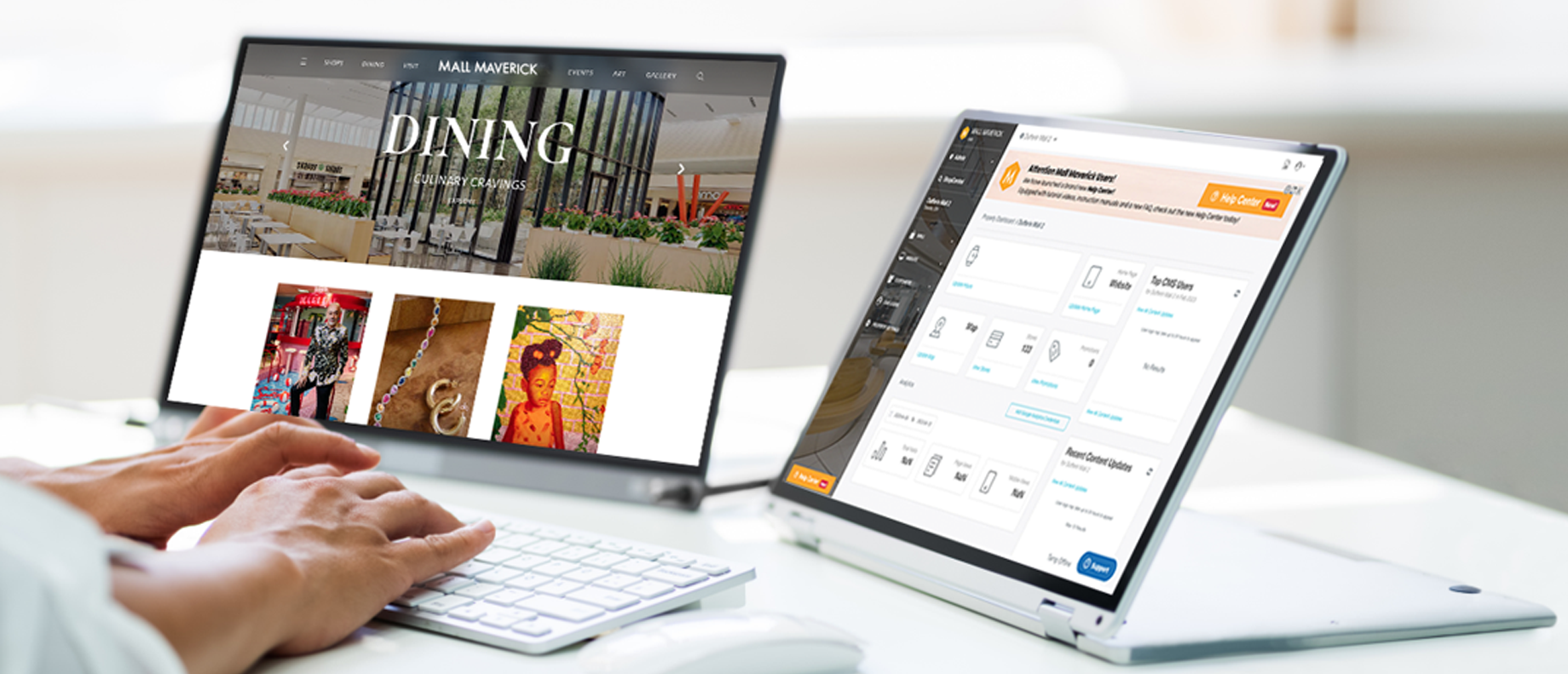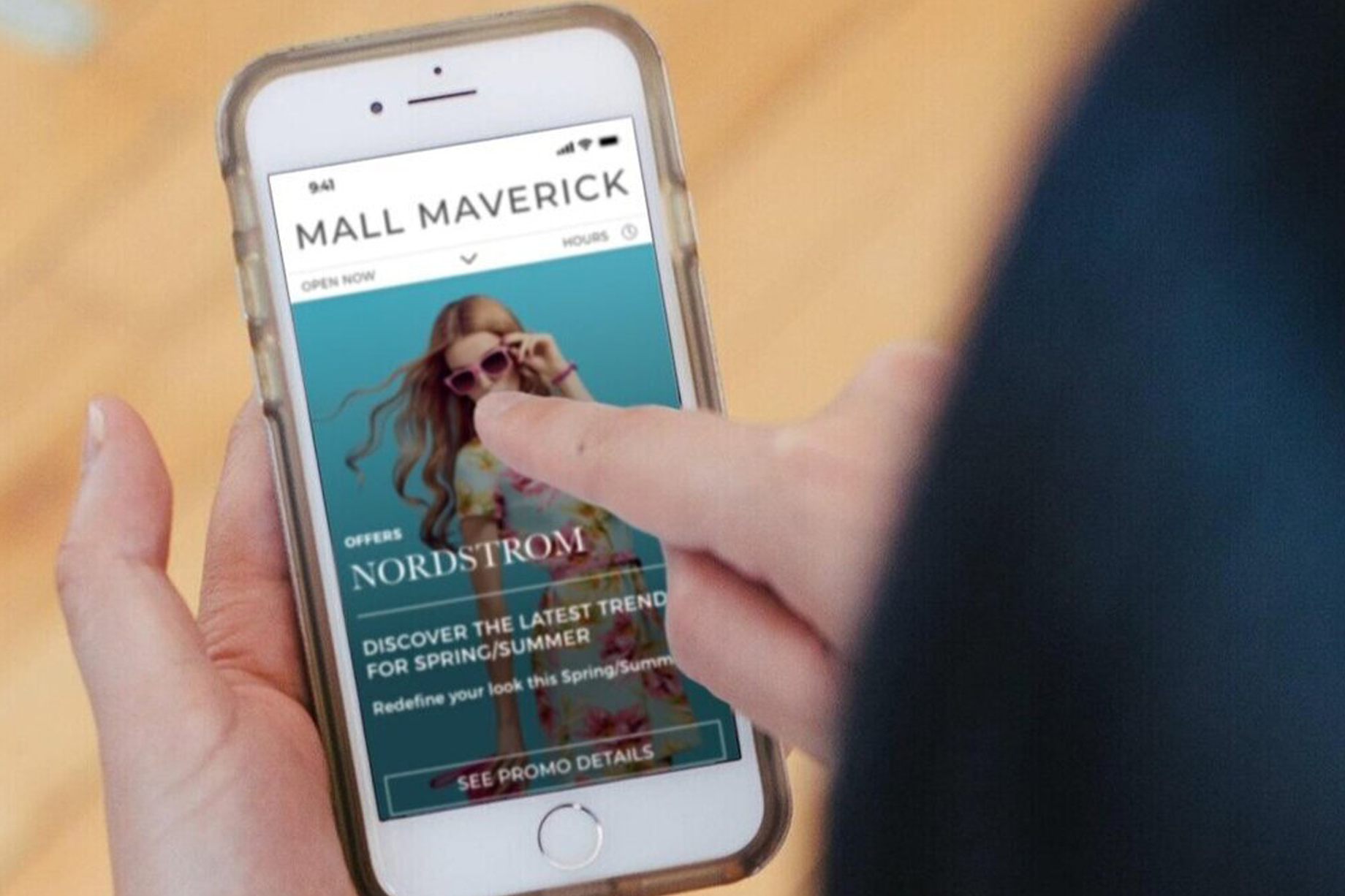While mall and retail center owners have traditionally focused on physical improvements to get the highest return on their investment, the value of a retail center has expanded far beyond its physical footprint.
Today, attracting investors, retailers, leasing brokers and foot traffic to your shopping center no longer begins in person. It begins online.
Brokers want to go beyond traditional leasing sheets and data models and see a property’s full digital plan and co-tenancies before even seeing it in person or picking up the phone to talk to a leasing representative.
Retailers and potential lessees want to see how well a retail center connects digitally with its audience and provides onsite and digital support compared to competitors. Just as landlords want to visit retailers’ and potential lessees’ websites and social channels to measure followers and brand esthetic.
Consumers now expect social media-friendly brand pop-ups, concerts and movie screenings in malls and retail centers, both big and small.
In short, malls are no longer just physical places where transactions take place. Following the pandemic, the value of a retail center, as suggested by Placer.ai, is its ability to be omnichannel and act as a hub for community engagement, entertainment, hospitality and more both in-person and online.
To deliver on this new promise, the current operating practices owners use simply don’t hold up. Having a website but using paper forms for guest services, phones for customer service, multiple apps to generate lease leads and third-party sites to run promotions is no longer sufficient. If anything, it’s costing owners valuable time, money, lease revenue and shoppers.
For mall and retail center owners to truly enhance a property’s value, they must use a single centralized platform that brings all these capabilities under one content management system, or CMS, like Mall Maverick. Only by doing so can they increase foot traffic, draw in better lease leads, increase tenant engagement, achieve brand consistency and take their digital efforts to the next level.
“Malls have become media platforms that must generate content — events, pop-ups, you name it — to keep people coming back. It’s given landlords a whole new set of responsibilities that require one, sophisticated CMS to get it done.”
— Sarah Malcolm, Quiet Valor, public relations for retail centers
A Centralized CMS Has Analytics That Increase Your Property’s Value
The future value of a retail center is not limited to its physical property or even its digital presence but more so the data it generates. Specifically, for every physical asset a center owns, there’s a digital representation of that asset, whether it’s a website, social media page, contact page, etc.
Many owners mistakenly assume having these digital assets alone is enough to add value. In fact, true digital wealth accumulates from converting those assets into big data.
According to a 2018 McKinsey & Co. report, new and unconventional data sources like surveys and Yelp reviews are becoming increasingly relevant for real estate investors and developers. Recognizing their importance, platforms like Mall Maverick even take it a step further by providing data around website views, newsletter subscribers, lease inquiries and more.
Collecting and analyzing data for your retail property becomes incredibly burdensome, if not impossible, without a centralized CMS. The right system will accommodate:
- content promotions
- e-newsletters
- interactive maps
- discovery trends for shoppers, retailers and investors
- digital contests and surveys
- experiential event management capabilities
Not only that, but it will provide owners the ability to track who’s visited each page, what features they interacted with and for how long.
With visitor data for a property or portfolio all in one place, it becomes that much easier to communicate these analytics to stakeholders who rely on them for investment, sales and leasing decisions.
“Every physical center has a digital representation. A simple community website with proper CMS enablement allows physical property teams to own, nurture and drive digital connection to the customer. It is a key differentiator for retail centers that are utilizing this channel to its full capabilities. This will lead to driving revenue and long-term value of your retail property as its digital wealth grows.”
— Lee Jackson, senior vice president of Digital Solutions Advisory, JLL

An All-Encompassing CMS Automates Your Digital Strategy
A state-of-the-art retail CMS automates a property’s activities, enhancing its ability to interact with stakeholders in real time and attract the right tenants, investors and shoppers.
Automation becomes critical for lease lead generation, especially, because it sets a property apart from its competitors.
Traditionally, leasing professionals have used one- to three-page leasing handouts to showcase a property’s significant retailers, key statistics and demographic data.
For years, these required one-to-one distribution, whether after a phone call or email inquiry. If any information changed, the entire document had to be updated, further delaying the leasing cycle.
With a CMS tool that automates these activities, brokers can distribute critical leasing information to interested and qualified parties 24/7. Further, because these sheets are connected to a central data dashboard, they’re updated in real time, reducing the need for ongoing human interaction, thus, empowering leasing professionals to focus on the work that matters and enhancing a center’s ability to attract the right retailers.
“The digital application forms we use on our shopping center websites for Pop Up and Grow and Leasing have helped to elevate our awareness of opportunities, streamline our efforts and centralize all of our leasing requests for both temporary and permanent retailers. Managing all applications in one place saves us valuable time and keeps us organized and focused on property profitability.”
— Rocky Viniard, vice president of marketing, Madison Marquette

Using One Industry Specific CMS Reduces Your Technology Costs
To create a valuable asset in today’s competitive retail landscape, owners must digitize and centralize all their efforts — leasing, IT, administrative, tenant management and marketing — into one CMS or risk taking on growing technical debt as an organization.
Technical debt accrues when a mall relies on technology that requires constant customization or manual intervention, offers outdated tools, is buggy, is disconnected or limits growth.
In the past, malls and retail centers have tackled technical debt in one of two ways. The first is using off-the-shelf systems like HubSpot, WordPress or Salesforce. The core problem with these, though, is they fall short of the needs of retail centers because there’s simply too much to do.
The second has been to take everything in-house. Larger portfolio managers have been known to hire an entire IT team and build personalized software only to realize later the steep cost to maintain it.
In reality, there’s now a third approach. Owners can find more efficient, affordable and effective alternatives using vendors in the marketplace that specialize in the retail center space, like Mall Maverick.
A single, sophisticated CMS allows malls and retail centers to take full control of their brands and maximize them across all physical and digital channels.
Through the right CMS platform, owners achieve:
- brand consistency and market perception of value
- best-in-practice website development and design
- increased search engine ranking to increase discoverability
- a robust customer relationship management system that centralizes shopper information
- a solid foundation for digital directory boards
- increased amount and quality of lease leads
With one CMS, owners and managers can phase out all others, eliminating their technical debt. This in and of itself increases a property’s value. Because all processes become connected, assets can generate leads, engage shoppers and attract new tenants seamlessly.
Why the Timing Is Right for a Single, Mall-Specific CMS
If you’re still unsure about upgrading your CMS, the time is now because malls and retail centers no longer service one stakeholder, but many:
- Investors: Investors looking for properties or portfolio-level opportunities for growth want assets that highlight retailers digitally and continuously invest in brand awareness, shopper communication and growth.
- Brokers: Leasing professionals need an easy system to showcase lease opportunities. A central CMS makes it much more efficient to generate leads, share property updates and display demographic information to retailers.
- Retailers: Retailers today are sophisticated and are looking for much more than just a space. They need marketing support and an owner or manager capable of managing mall-wide promotions, special offers, events and product launches.
- Shoppers: Along the same lines, shoppers need ways to stay engaged with properties, whether it’s through newsletters, sales promotions, incentives, store information or other avenues.
- Marketers: The right, centralized CMS makes the job of retail center marketers to keep these shoppers engaged cost-effective by allowing all of these activities to be organized and managed in the same place.
Overall, only by leveraging a robust CMS where you’re able to create value for all stakeholders are you able to build a strong shopper base, attract aspirational tenants and accelerate the leasing process, leading to higher rental rates and value appreciation over time.
Getting Started
Without using a centralized platform specifically built for malls and retail shopping centers, your company loses valuable time and money.
The mall and retail centers that have managed to survive and thrive post pandemic understand this and are using specialized vendors like Mall Maverick to bring everything under one roof.
With a proven track record and innovative product, Mall Maverick expertly works with a center’s entire team — retailers, marketers, brokers and guest services — to automate the marketing, leasing, event planning and engagement of a mall or retail shopping center.
To learn more, visit Mall Maverick here.